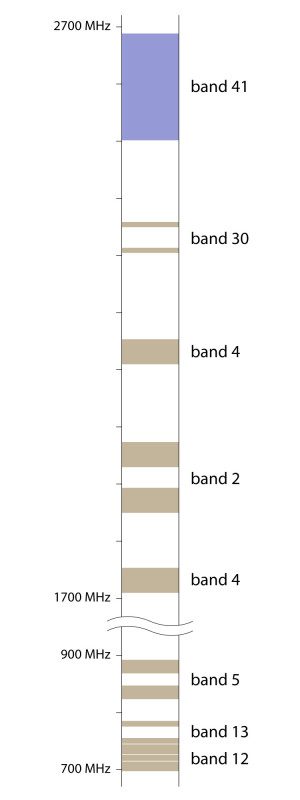Band 41

A relatively high-frequency radio band. In the US, it is used almost exclusively by T-Mobile (and previously by Sprint before the companies merged). T-Mobile originally deployed in this band, but is now repurposing it for mid-band 5G (starting in 2019.)
Band 41 is an unpaired band, meaning there is only one contiguous block of spectrum, instead of one for uplink (phone-to-tower), and one for downlink (tower-to-phone). Therefore, in order to facilitate two-way communication, band 41 is specified for TDD operation instead of FDD. Basically, the phone and the tower "take turns" talking to each other over the same radio frequencies.
See: TDD
Band 41 spans 2,502 - 2,690 MHz, which is a relatively large amount of bandwidth, capable of handling a large amount of data at high speeds. However, this range of frequencies is higher than most bands used for mobile phones. That means band 41 signals do not reach as far, nor penetrate buildings and other objects, as well as bands in lower frequency ranges.
Band 41 is a much lower frequency than mmWave, though, which means it reaches farther and penetrates solids better than mmWave.
See: mmWave
Because it sits between traditional bands and mmWave, some now refer to frequencies in this range as "mid-band".
Before Sprint used band 41 for 4G LTE, they deployed the ill-fated WiMax 4G technology in the same frequency band.
See: WiMax
The frequency range of band 41 was originally designated the BRS band, and was intended for "wireless cable" service.
See: BRS
Last updated Apr 19, 2022 by Rich Brome
Editor in Chief Rich became fascinated with cell phones in 1999, creating mobile web sites for phones with tiny black-and-white displays and obsessing over new phone models. Realizing a need for better info about phones, he started Phone Scoop in 2001, and has been helming the site ever since. Rich has spent two decades researching and covering every detail of the phone industry, traveling the world to tour factories, interview CEOs, and get every last spec and photo Phone Scoop readers have come to expect. As an industry veteran, Rich is a respected voice on phone technology of the past, present, and future.









